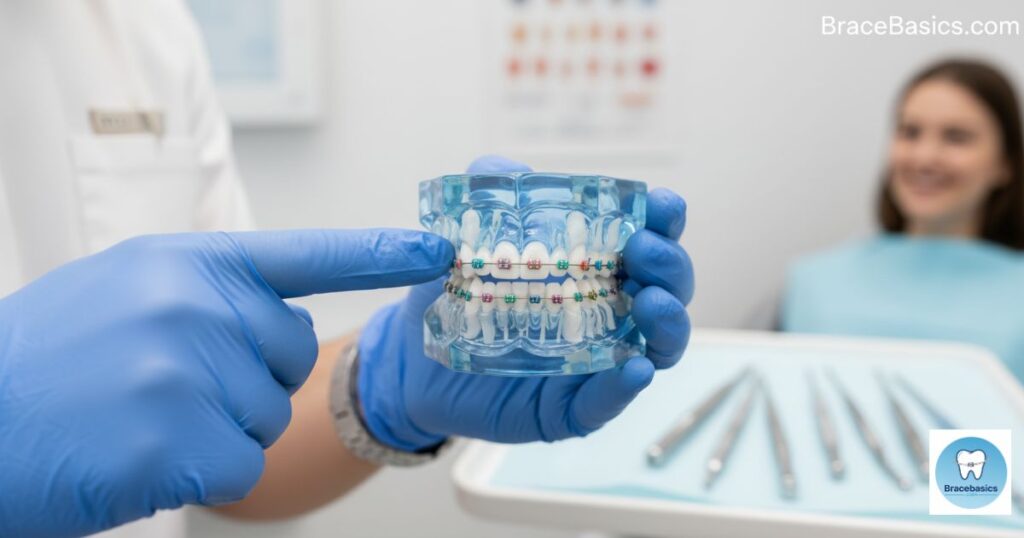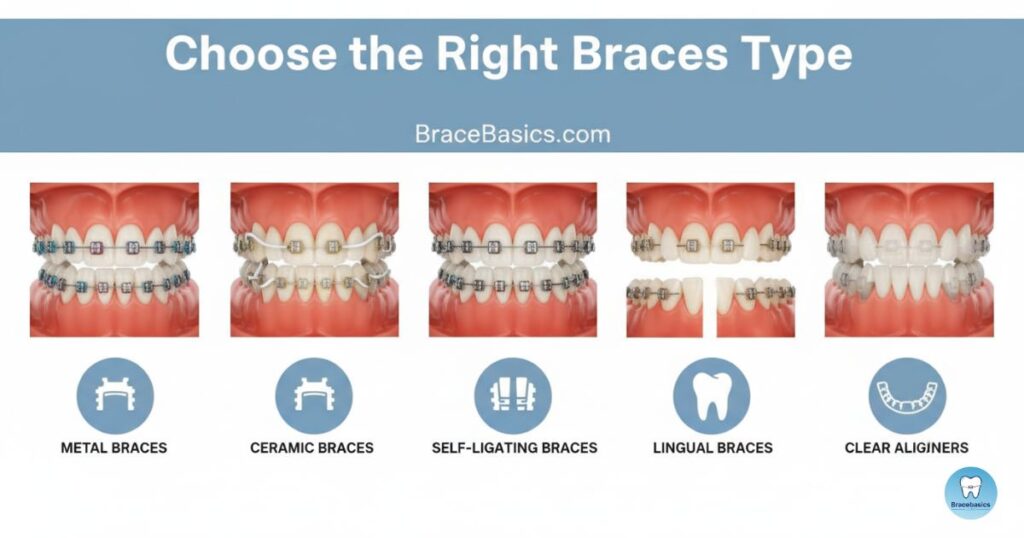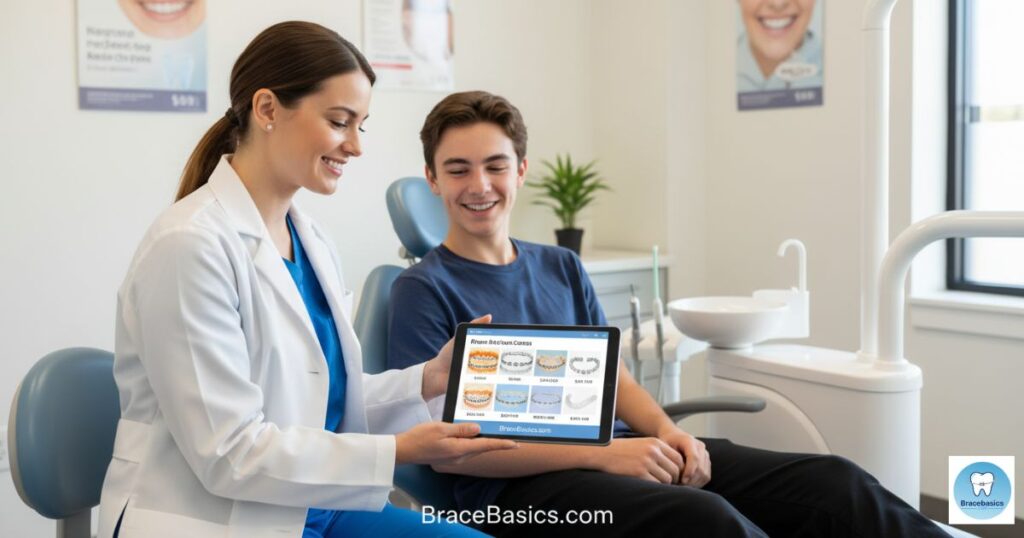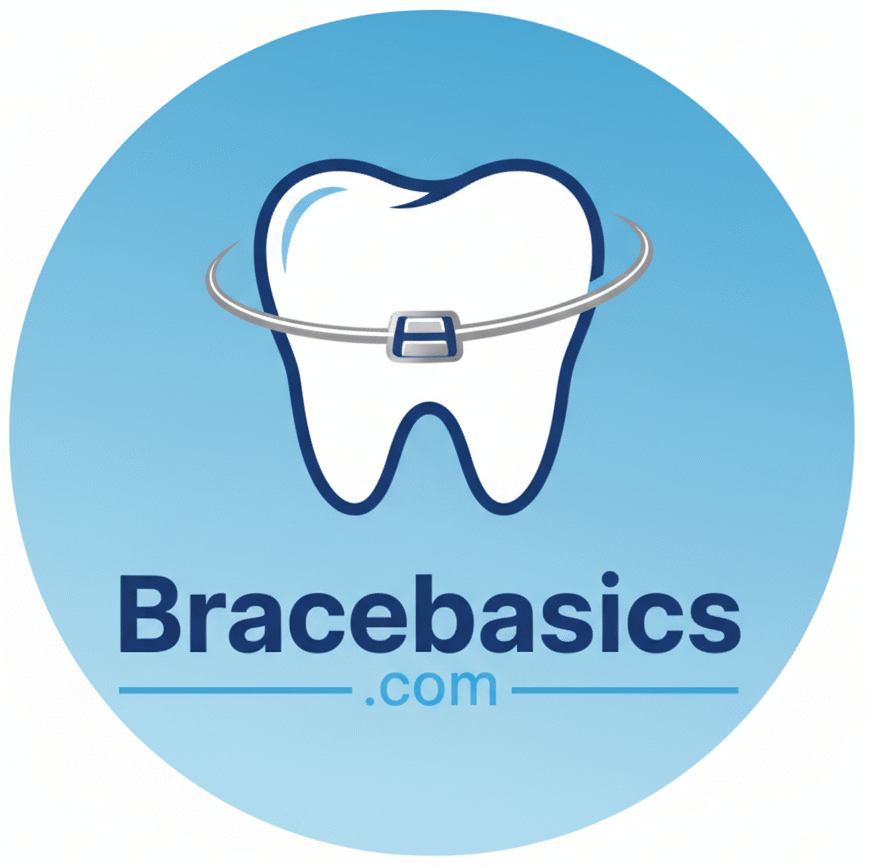Types of Braces play a major role in shaping not just your smile but also your confidence and comfort. In today’s world of advanced orthodontic treatment, choosing the right braces can transform your dental health journey. Whether you’re looking for metal braces, clear braces, or modern clear aligners, each option offers a unique path toward achieving perfectly straight teeth. Picking wisely ensures less discomfort, a faster process, and results you’ll love to show off. Modern dentistry now offers everything—from classic metal designs to invisible braces that blend effortlessly with your lifestyle.
What Are Braces?

Braces are devices fixed or removable that apply controlled force to teeth so they slowly shift into correct positions. They treat issues of dental misalignment, crooked teeth correction, gapped teeth correction, and malocclusion treatment. In short, braces are a key tool in any orthodontic issues plan to straighten your smile.
How Do Braces Work?
Braces move teeth by applying pressure and tension over time. The bracket-wire combination gradually remodels bone around roots while the teeth shift. This biological response—bone remodeling—lets the teeth settle into new locations, achieving proper alignment. That is how braces work at a cellular level.
Different Types of Braces

When considering types of braces, you’ll find five major categories. Each style adapts differently to budgets, aesthetics, comfort, and treatment complexity.
Metal Braces (Traditional Braces)
Metal braces use stainless steel brackets and wires to guide teeth into alignment. They remain the backbone of children braces and adult braces because of their durability and proven effectiveness in complex cases.
Pros: affordable, durable, effective for all cases
Metal braces usually cost less than newer types yet deliver reliable results in even severe alignment problems. They resist wear and handle pressure.
Cons: visible, may cause slight discomfort
Because braces are highly visible, many adults shy away from them. After braces adjustment or braces tightening, soreness is common.
Best for: children and teens with moderate to severe misalignment
When you need a strong solution for crowded teeth solution or bite issues, metal braces remain trusted by orthodontists.
Ceramic Braces (Clear Braces)
Ceramic braces, or clear braces, use tooth-colored or transparent brackets that blend with your enamel. They offer a more subtle appearance for people who want straighter teeth without obvious metal gear.
Pros: aesthetic, less visible, effective
They look more natural in use. Many adults prefer them in adult braces plans because they’re less noticeable while working just as well in many alignment scenarios.
Cons: costlier, can stain easily
The ceramic material is more brittle. Also, foods or drinks like coffee or tea may discolor brackets if you don’t keep up with oral hygiene with braces.
Best for: adults who want discreet treatment
If you care about aesthetics during treatment, ceramic braces often balance looks and function well.
Self-Ligating Braces
Self-ligating braces replace elastics or ties with built-in clips or sliding doors. That means less friction and often fewer visits to your orthodontist.
Pros: fewer visits, smoother tooth movement, easier cleaning
Without rubber ligatures, cleaning is simpler and the sliding mechanism may reduce pressure. Some patients experience less discomfort. Healthline+2Granger Orthodontics+2
Cons: higher cost
They tend to cost more, and not every orthodontic office offers all self-ligating systems. Auld Family Dentistry+2Rendon Orthodontics+2
Best for: patients seeking comfort and shorter treatment time
For people who prefer fewer appointments and gentler adjustments, these can be a good fit—if your condition allows it. Oliver Orthodontics+2Orthodontics Australia+2
What Do Rubber Bands Do for Braces?
Lingual Braces (Hidden Braces)
Lingual braces attach on the back (lingual side) of the teeth, making them invisible from the front. This is a truly hidden orthodontic option for those who want discreet treatment.
Pros: completely hidden
Since they’re behind the teeth, others usually can’t see that you’re wearing braces.
Cons: difficult to clean, affects speech initially, expensive
Cleaning is trickier. Speech or tongue comfort may suffer at first. Also, cost is high because of custom design and more labor.
Best for: adults focused on aesthetics
If invisibility is a must, lingual braces let you straighten your smile with minimal visible hardware.
Clear Aligners (Invisalign and Similar Brands)
Clear aligners are nearly invisible trays—think Invisalign aligners or ClearCorrect aligners—that you can remove to eat and clean. They’ve reshaped the idea of braces for many people.
Pros: removable, invisible, comfortable
You can take them out to brush, floss, and enjoy most foods. Many find them less intrusive than fixed braces.
Cons: not suitable for severe cases, costly, requires discipline
If your misalignment is extreme, aligners may not work well. You must wear them nearly full time.
Best for: adults or teens with mild misalignment
When you want a low-profile option and are committed to compliance, clear aligners may be ideal.
Which Type of Braces Is Right for You?

Choosing among metal braces, ceramic braces, lingual braces, self-ligating braces, and clear aligners involves judging trade-offs. You weigh visibility, cost, comfort, and how severe your orthodontic issues are. A person with moderate crowding might choose ceramic or self-ligating for a balance of looks and function. Someone with simple spacing may prefer clear aligners. A case needing major bite correction often does best with metal or self-ligating. Always ask your orthodontist consultation to map your case and preferences.
Cost Comparison of Different Braces
“How much do braces cost?” is a key question. In the USA, metal braces often range $3,000 to $7,500. Clear braces (ceramic) fall around $4,000 to $8,500. Self-ligating braces sit between $4,000 to $7,500, while lingual braces may reach $8,000 to $13,000+. Clear aligners, like Invisalign and ClearCorrect, typically cost $3,500 to $7,500 depending on complexity. Joosse Family Orthodontics+5smileworksnyc.com+5smile2impress.com+5
Here’s a cost table:
| Type of Braces | Approx. Cost (USD) | Notes |
| Metal Braces | $3,000 – $7,500 | Most affordable conventional option |
| Clear (Ceramic) Braces | $4,000 – $8,500 | More aesthetic but less durable |
| Self-Ligating Braces | $4,000 – $7,500 | Advanced tech, fewer visits |
| Lingual Braces | $8,000 – $13,000+ | Hidden behind teeth |
| Clear Aligners | $3,500 – $7,500 | Invisible, removable, needs compliance |
Insurance, region, complexity, and orthodontist fees all influence final cost. Many practices offer payment plans or financing to help.
Final Thoughts
You now know five major types of braces—metal braces, ceramic braces, self-ligating braces, lingual braces, and clear aligners—and how they differ. Your ideal choice depends on your budget, aesthetic priorities, and the complexity of your dental misalignment. Speak with an experienced orthodontist who can tailor a plan based on how braces work, your lifestyle, and expectations. Good braces maintenance tips, consistent orthodontic appointments, and a solid dental care routine will maximize your chances of lasting success. Your confident, straight smile is within reach.
FAQs
Which is the best type of braces?
The best type of braces depends on your orthodontic needs, budget, and lifestyle. Metal braces are the strongest and most effective for severe misalignment. Ceramic braces are great if you want a more natural look. Clear aligners, like Invisalign aligners, are best for mild to moderate crooked teeth correction because they’re removable and invisible. Always ask your orthodontist which option suits your dental braces treatment best.
What’s the most painful type of braces?
Most people feel slight discomfort with any orthodontic treatment, especially after braces tightening. However, lingual braces can cause more soreness because they sit behind your teeth and may irritate the tongue at first. The pain usually fades in a few days as your mouth adjusts. You can use over-the-counter pain relievers or dental wax for braces to ease irritation.
Is $5000 expensive for braces?
In the USA, $5,000 is the average cost of braces, not too expensive but also not the cheapest. Metal braces usually cost between $3,000 and $7,000, while Invisalign aligners or clear braces can reach $8,000 depending on your case and clinic location. Factors like treatment length, materials, and orthodontist consultation fees affect the total price. Always ask for a detailed quote before starting dental braces treatment.
What are the five types of braces?
There are five main types of braces used in modern orthodontic treatment:
- Metal braces – strong, affordable, and suitable for all ages.
- Ceramic braces – clear and aesthetic, great for adults.
- Self-ligating braces – require fewer visits and move teeth faster.
- Lingual braces – hidden behind the teeth for a discreet look.
- Clear aligners – like Invisalign or ClearCorrect aligners, removable and almost invisible.
Each type offers different benefits for teeth straightening, so your orthodontist consultation will help you choose the best fit.
References
- American Association of Orthodontists (AAO) — for standards and guidelines
- Colgate Oral Health Center — overview on braces
- Cleveland Clinic – Dental Braces (how braces correct alignment)
- WebMD – Orthodontic Treatments (risks, benefits, options)
- Healthline – Self-Ligating Braces (mechanism, pros/cons) Healthline
- SmileWorks NYC – Cost guide for braces types smileworksnyc.com
- Research articles on bracket systems and self-ligating vs conventional

Hi, I’m Dr. Martin, the founder of BracsBasics.com. With years of experience in orthodontics, I’ve made it my mission to simplify braces care for patients of all ages. Here, you’ll find easy-to-understand advice, practical tips, and reliable resources to make your braces journey smoother, healthier, and stress-free. My goal is to help you smile with confidence every step of the way.

